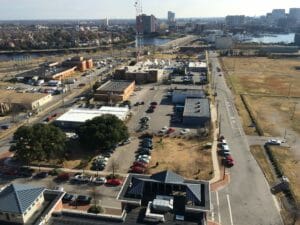Top Story
Date: December 14-19, 2014
Location: Norfolk, Virginia
Sponsor: City of Norfolk
Subject Area: Resilience
Panel Chair: John McIlwain
For the panel report, please visit ULI’s Knowledge Finder
BACKGROUND AND PANEL ASSIGNMENT
The Hampton Roads region has received national attention on the issue of sea-level rise. Regional land subsidence combined with coastal geography mean that the region faces the highest rate of sea-level rise on the East Coast of the United States. Over the last 85 years mean sea level has risen 14.5 inches in the region, compared to a global rise of 8 inches over 140 years. While addressing the challenges of climate and geography, the City of Norfolk is also seeking to create a more vibrant and livable community for its residents.
The panel studied the Fort Norfolk neighborhood, previously known as Atlantic City, which lies just northwest of downtown Norfolk. The study area has a diverse mix of existing uses, including a senior living facility, surface parking, offices for the Army Corps of Engineers, the Red Cross, and People for the Ethical Treatment of Animals (PETA), and a television station. The site also has a substantial amount of vacant land along the waterfront. The site was the subject of a previous ULI panel in 2002. Since that time a major infrastructure change has occurred in the Tide light rail system, which terminates at the entrance to Fort Norfolk, adjacent to the Eastern Virginia Medical Campus.
Using the Fort Norfolk neighborhood as a lens, the City aims to align its land use policies, economic development plans, and infrastructure investments in a way that protects existing cultural and economic assets, but will also create new opportunities for a resilient and thriving Norfolk. To this end, the panel was asked to assess the existing value and market potential of properties in the neighborhood and to make recommendations for how to invest in resilience in the neighborhood while also fulfilling the City’s vision for it as a socially equitable, transit-oriented opportunity for much needed jobs and housing.
SUMMARY OR RECOMMENDATIONS
Among the panel’s recommendations were:
- Build out from the Tide Station. While much of the attention in the study area has focused on market potential for waterfront properties, the panel’s analysis suggested that development potential in those areas was limited. Instead the panel suggested focusing any new development near the Tide Light Rail Station to draw activity in to the neighborhood.
- Create a Coastal Urban Resilience Institute. Norfolk has gotten national attention because of the issue of sea-level rise. The panel suggested that the city could take ownership of the issue and become a leader on solutions in a way that would activate and incubate small business, create partnerships with local universities, and drive activity to the study area.
- Community Space at the Water’s Edge. Reversing a previous plan to build up residential and mixed-use development at the waterfront, the panel suggested that the market wouldn’t support this plan. Instead, the panel saw an opportunity to provide much needed open space, connectivity, and community engagement with the waterfront through bike trails and recreational space.
- Activate the Site. The panel suggested low-cost and low-intensity ways to provide thoughtful programming in the study area that would not require permanent development. Maker’s fairs, food truck events, and temporary art spaces are all ways that would create an interest in the area and begin to define a character for it. These activities could also be oriented towards a vision of the neighborhood as a center of innovation, particularly around the issue of sea-level rise.

